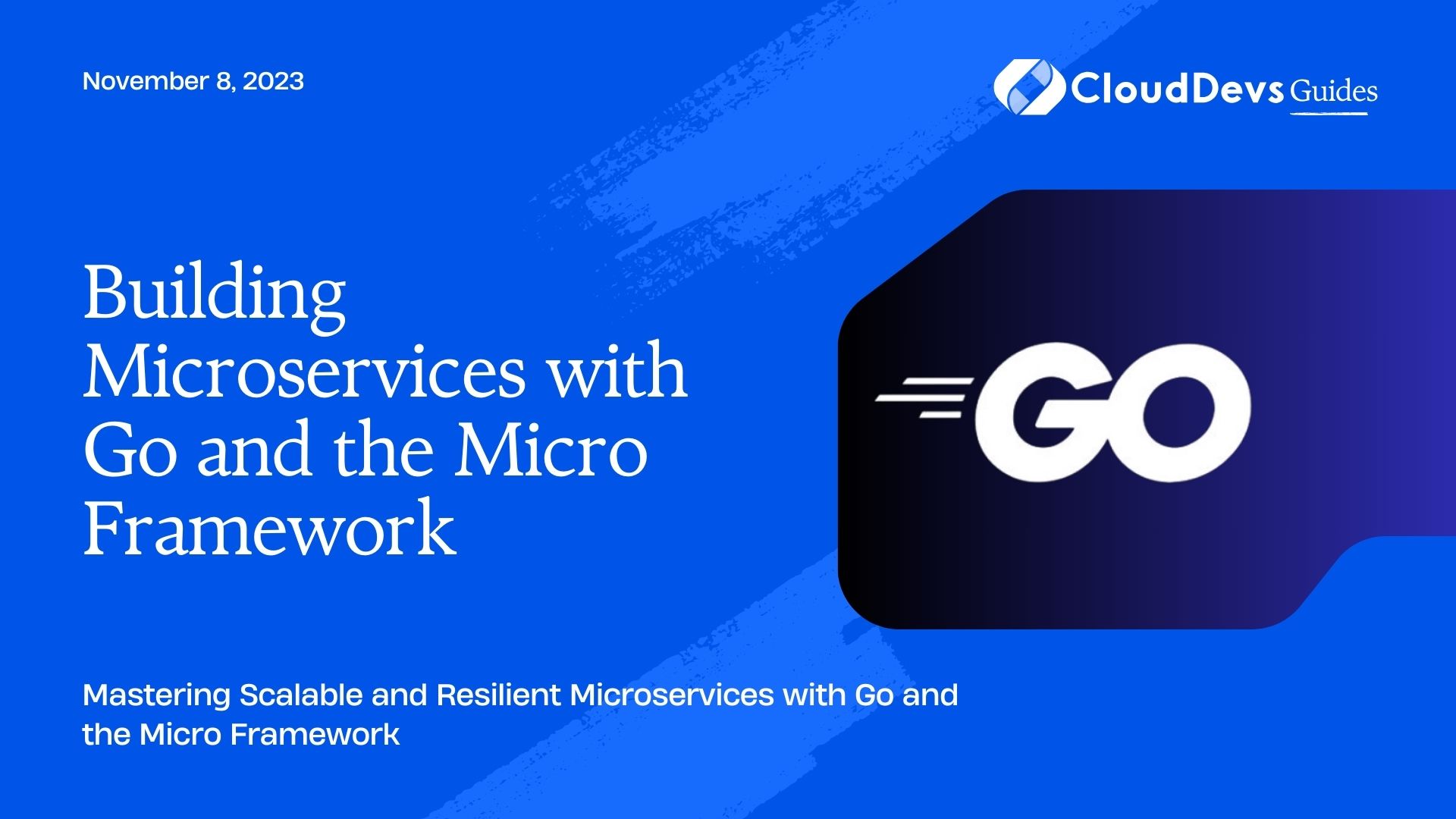Building Microservices with Go and the Micro Framework
In the ever-evolving landscape of software development, microservices architecture has emerged as a powerful approach to building scalable, maintainable, and efficient applications. Microservices break down complex applications into smaller, independent services that communicate with each other through APIs, providing numerous benefits in terms of flexibility, scalability, and fault tolerance.
In this blog post, we will explore how to build microservices using the Go programming language and the Micro framework. We’ll dive into the fundamentals of microservices, set up a development environment, create microservices, and demonstrate how they can work together to create a robust distributed system. Along the way, we’ll provide code samples and explanations to help you grasp the concepts and start building your own microservices with confidence.
1. Understanding Microservices
1.1. What are Microservices?
Microservices are an architectural style for building software applications as a collection of small, independent services. Each service is responsible for a specific piece of functionality and communicates with other services through well-defined APIs, often using lightweight protocols like HTTP or gRPC. This modular approach to development promotes scalability, maintainability, and agility.
1.2. Key Characteristics of Microservices
- Independence: Each microservice operates independently, with its own database and codebase. This independence reduces the risk of system-wide failures.
- Decentralization: Microservices enable decentralization of decision-making, making it easier to adopt technologies and frameworks that suit specific service needs.
- Scalability: You can scale individual microservices independently to handle varying loads, optimizing resource utilization.
- Fault Tolerance: When one microservice fails, it doesn’t necessarily bring down the entire application. Other services can continue functioning, and fault tolerance can be designed at the service level.
- Polyglot Persistence: Each microservice can use the most suitable database technology for its requirements.
2. Setting Up Your Development Environment
Before we dive into creating microservices with Go and the Micro framework, let’s ensure you have the necessary tools and dependencies installed on your system.
2.1. Prerequisites
- Go Programming Language: If you haven’t already, install Go on your system. Go is a fantastic choice for building microservices due to its performance and simplicity.
- Docker: We’ll use Docker for containerization, which is crucial for deploying and scaling microservices. Install Docker on your machine.
- Micro Framework: The Micro framework simplifies microservices development. Install it using Go’s package manager:
bash go get github.com/micro/micro/v3
With these prerequisites in place, you’re ready to start building microservices with Go and the Micro framework.
3. Creating Your First Microservice
Let’s begin by creating a basic microservice using Go and the Micro framework. We’ll create a simple “Hello, Microservice!” service to get started.
3.1. Project Structure
In a typical microservices project, you’ll organize your code into separate directories for each service. For this example, create a directory named microservices to house your microservices projects:
bash mkdir microservices cd microservices
Now, let’s create our “Hello, Microservice!” service.
3.2. Service Code
Inside your microservices directory, create a file named main.go for your microservice code:
go
// main.go
package main
import (
"log"
"github.com/micro/micro/v3/service"
)
func main() {
// Create a new service
srv := service.New()
// Define your service
srv.Handle(service.NewHandler(func(ctx context.Context, req Request, rsp Response) error {
return rsp.Write("Hello, Microservice!")
}))
// Run the service
if err := srv.Run(); err != nil {
log.Fatal(err)
}
}
In this code:
- We import the necessary packages, including the Micro framework.
- We create a new Micro service.
- We define a service handler that responds with “Hello, Microservice!” when called.
- We run the service, handling any potential errors.
3.3. Building and Running Your Microservice
To build and run your microservice, execute the following commands within the microservices directory:
bash go build ./microservices
Your microservice should now be up and running, ready to accept requests.
4. Service Discovery and Communication
One of the key challenges in microservices architecture is enabling services to discover and communicate with each other effectively. The Micro framework simplifies this by providing built-in tools for service discovery and communication.
4.1. Service Registration and Discovery
When you run a microservice using the Micro framework, it registers itself with the service registry, making it discoverable by other services. The service registry keeps track of available services, their locations, and endpoints.
4.2. Service-to-Service Communication
Microservices often need to communicate with each other to fulfill business logic. With the Micro framework, this communication is straightforward. You can use HTTP, gRPC, or other protocols to make requests to other services. Here’s an example of how you can call another microservice from your Go code:
go
// Import the necessary package
import (
"github.com/micro/micro/v3/client"
)
func main() {
// Create a client to communicate with other services
c := client.NewClient()
// Call another microservice
rsp := c.Call(context.Background(), client.NewRequest("example", "Hello.Call", "RequestData"))
// Handle the response
if rsp.Error != nil {
log.Fatal(rsp.Error)
}
log.Println(rsp.Body)
}
In this example, we use the Micro framework’s client package to call another microservice named “example” and invoke the “Hello.Call” method with request data “RequestData.”
5. Scaling Your Microservices
One of the major advantages of microservices architecture is the ability to scale individual services independently to meet varying demands. The Micro framework makes scaling easy with Docker and Kubernetes integration.
5.1. Containerization with Docker
To scale your microservices, you can containerize them using Docker. Docker containers encapsulate your microservice and its dependencies, ensuring consistent deployment across different environments.
Here’s a basic Dockerfile for containerizing a Go-based microservice:
Dockerfile # Use the official Go image as the base image FROM golang:1.16 # Set the working directory inside the container WORKDIR /app # Copy the Go application code into the container COPY . . # Build the Go application inside the container RUN go build # Expose the port your microservice listens on EXPOSE 8080 # Define the command to run your microservice CMD ["./microservices"]
You can then build and push this Docker image to a container registry like Docker Hub or Amazon ECR.
5.2. Orchestrating with Kubernetes
Kubernetes is a powerful container orchestration platform that allows you to deploy and manage containerized microservices at scale. The Micro framework provides Kubernetes integration, making it seamless to deploy and scale your microservices on a Kubernetes cluster.
To deploy a microservice on Kubernetes, you can define a Kubernetes deployment manifest:
yaml
apiVersion: apps/v1
kind: Deployment
metadata:
name: hello-microservice
spec:
replicas: 3
selector:
matchLabels:
app: hello-microservice
template:
metadata:
labels:
app: hello-microservice
spec:
containers:
- name: hello-microservice
image: your-docker-image:tag
ports:
- containerPort: 8080
In this example, we define a deployment for our “Hello, Microservice!” microservice with three replicas. Kubernetes will ensure that these replicas are distributed and maintained across your cluster.
Conclusion
Building microservices with Go and the Micro framework offers a powerful and flexible approach to creating scalable, distributed systems. We’ve covered the basics of microservices, setting up your development environment, creating a simple microservice, handling service discovery and communication, and scaling with Docker and Kubernetes.
As you explore microservices further, you’ll encounter various challenges related to data consistency, security, and monitoring. However, armed with the knowledge and tools provided in this blog post, you’re well on your way to mastering the art of microservices development with Go and the Micro framework. Start small, experiment, and gradually build more complex microservices to create robust, maintainable applications in the modern software landscape. Happy coding!
Incorporating microservices into your software architecture can bring tremendous benefits, but it also introduces complexities that need to be managed effectively. By leveraging Go and the Micro framework, you can build microservices that are scalable, resilient, and easy to develop and deploy. Whether you’re starting a new project or transitioning an existing one, this blog post serves as a solid foundation for embarking on your microservices journey with confidence.
Table of Contents







